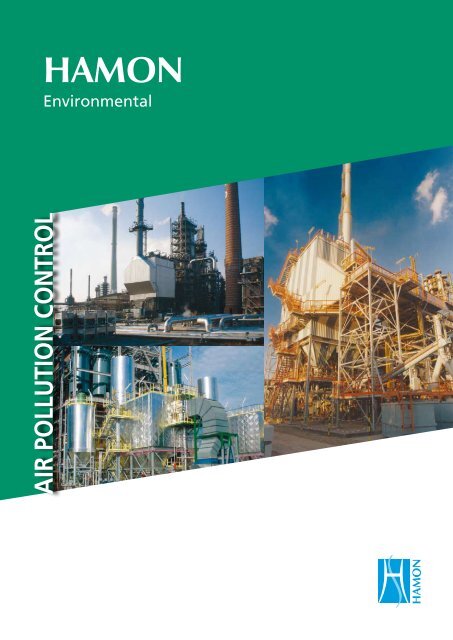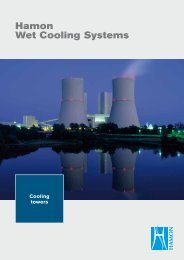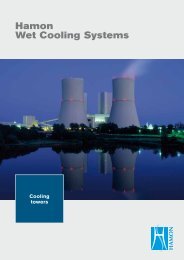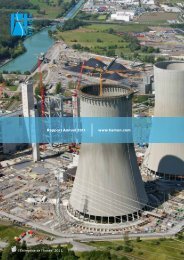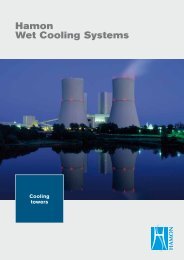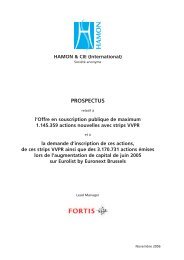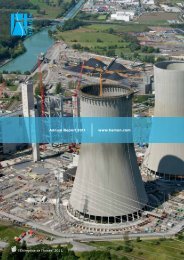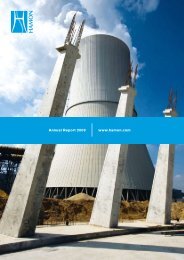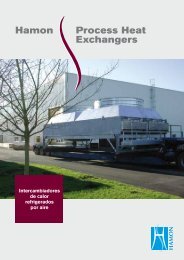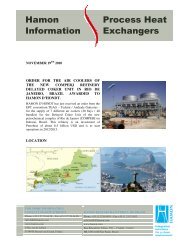AIR POLLUTION CONTROL - Hamon
AIR POLLUTION CONTROL - Hamon
AIR POLLUTION CONTROL - Hamon
You also want an ePaper? Increase the reach of your titles
YUMPU automatically turns print PDFs into web optimized ePapers that Google loves.
environmental<br />
<strong>AIR</strong> <strong>POLLUTION</strong> <strong>CONTROL</strong> HAMON<br />
<strong>Hamon</strong> Research-Cottrell<br />
<strong>Hamon</strong> Environmental<br />
Walther
<strong>Hamon</strong> Environmental in a few words<br />
In 1906, the <strong>Hamon</strong> Group started its industrial activity<br />
in Europe and developed the cooling tower business<br />
with growing mining and heavy industry sectors. Since<br />
then, <strong>Hamon</strong> became a world leader in the product<br />
lines it chose to be in, respectively: wet cooling towers,<br />
air-cooled heat exchangers, air pollution control equipment<br />
and chimneys.<br />
Nowadays, the <strong>Hamon</strong> Group operates in the Air<br />
Pollution Control field through two main organisations,<br />
<strong>Hamon</strong> Research-Cottrell in the USA and <strong>Hamon</strong><br />
Environmental in Europe, sharing technologies and<br />
experience.<br />
2<br />
<strong>Hamon</strong> Environmental<br />
<strong>Hamon</strong> Environmental, European business unit of the<br />
Air Pollution Control Division of the <strong>Hamon</strong> Group,<br />
has been created by the merging of the activities of<br />
Research-Cottrell and Walther France, with the purpose<br />
to create an integrated organisation capable to serve the<br />
global market of Air Pollution Control.<br />
<strong>Hamon</strong> Research-Cottrell began when Dr. Frederick<br />
Gardner Cottrell invented the first industrial electrostatic<br />
precipitator in 1907. To support scientific research,<br />
Dr. Cottrell co-founded the non-profit Research<br />
Corporation in 1912. Forty years later, Research<br />
Corporation gave birth to Research-Cottrell.<br />
<strong>Hamon</strong> Environmental continues the tradition of<br />
engineering excellence by designing, building, and<br />
servicing quality Air Pollution Control Systems for the<br />
industries and utilities of the world.<br />
<strong>Hamon</strong> Group<br />
The Air Pollution Control Division<br />
<strong>Hamon</strong> <strong>Hamon</strong><br />
Research-Cottrell Inc. Research-Cottrell s.a.<br />
USA � � � � � � � � Belgium<br />
<strong>Hamon</strong> <strong>Hamon</strong><br />
Research-Cottrell Environmental s.a.r.l.<br />
do Brasil s.a. France<br />
Mission<br />
<strong>Hamon</strong><br />
Research-Cottrell s.a.<br />
Italy<br />
<strong>Hamon</strong> Environmental<br />
Deutschland GmbH<br />
Germany<br />
<strong>Hamon</strong><br />
Environmental<br />
Europe<br />
Reducing emissions is a complex task for any industry.<br />
The result must not only comply with present and<br />
future regulatory requirements, it must also integrate<br />
the needs of your specific production process, schedule<br />
and budget.<br />
<strong>Hamon</strong> Environmental has decades of experience<br />
in the engineering, design, construction, start-up,<br />
operation and maintenance of air pollution control<br />
systems. In order to test and optimize many of our<br />
engineering designs, we have conducted our own inhouse<br />
flow dynamics models and computer simulations.<br />
This experience, which includes countless emission<br />
control systems for numerous and varied processes,<br />
allows us to confidently apply technology to your<br />
specific requirements.<br />
Knowledge and Understanding of Regulations<br />
The ever-changing industrial and governmental rules<br />
and regulations is a challenge that <strong>Hamon</strong> Environmental<br />
readily accepts. We constantly monitor the<br />
regulations to ensure that our systems, parts and<br />
services meet the shifting and more stringent demands.
HAmoN ENvIRoNmENTAl<br />
Main Product Lines<br />
DUST<br />
EMISSION<br />
<strong>CONTROL</strong><br />
Dry and Wet<br />
ESP’s<br />
Fabric Filters<br />
Hybrid Collectors<br />
Multicyclones<br />
Flue Gas<br />
Conditioning<br />
Impingement<br />
Scrubbers<br />
ESP electrostatic precipitator<br />
FF fabric filter<br />
FGT flue gas treatment<br />
FGD flue gas desulphurization<br />
SCR selective catalytic reduction<br />
SNCR selective non-catalytic reduction<br />
CFm computerized flow modeling<br />
ACID GAS<br />
REMOVAL<br />
SYSTEMS<br />
Dry type<br />
FGT Systems<br />
Semi-Dry FGT<br />
Systems<br />
Combined Wet/Dry<br />
FGT Systems<br />
Dioxines and Heavy<br />
Metals Control<br />
Wet FGD scrubbing<br />
for Industrial Boilers<br />
and Diesel Engines<br />
Wet FGD Exxon<br />
Process for FCCU<br />
NOx<br />
REMOVAL<br />
SYSTEMS<br />
SCR DeNOx<br />
Systems<br />
NOx and CO<br />
Catalyst SCR<br />
Tail end or<br />
high Dust SCR<br />
SNCR DeNOx<br />
Systems<br />
U 2 A – Urea to<br />
Ammonia System<br />
Main segments of activity<br />
CUSTOMER<br />
SERVICE<br />
ESP and FF large<br />
Rebuilds<br />
Repairs and<br />
Maintenance<br />
Spare<br />
Parts<br />
Diagnostic<br />
and CFM<br />
<strong>Hamon</strong> Environmental technology founds main application for :<br />
K Power generation<br />
– large utility boilers<br />
– industrial boilers<br />
– diesel generators stations<br />
– gas turbines combined cycles<br />
K Waste incineration<br />
K Biomass<br />
K Refineries<br />
K Glass industry<br />
K Cement and ore industry<br />
K Steel and non-ferrous industry<br />
K Fertilisers industry<br />
3
HAmoN ENvIRoNmENTAl<br />
Electrostatic Precipitators<br />
4<br />
For nearly a century, electrostatic precipitators (ESP’s) have<br />
been the preferred air pollution control technology for<br />
power generation and industrial processes throughout<br />
the world. ESP’s are highly effective dust collectors with<br />
proven collection efficiencies of up to 99,99% with guaranteed<br />
outlet emissions as low as 10 mg/Nm 3 with<br />
minimal pressure loss.<br />
Fact and figures:<br />
K Gas flow over 2 000 000 Nm 3 /h<br />
K Collecting plate height over 15 m<br />
K High frequency transformer efficiency<br />
K ESP’s on power plant in excess of 1 000 units and<br />
200 000 mWe<br />
K ESP’s supplied for all industrial processes such as:<br />
– Power generation/utilities<br />
– oil refineries<br />
– Waste and sludge incineration plants<br />
– Biomass plants<br />
– Cement and ore industry<br />
– Steel and non-ferrous industry<br />
– Glass furnaces<br />
– Pulp and paper<br />
Total ESP’s installed by <strong>Hamon</strong> Environmental:<br />
> 5 000 units.
Hi-R type ESP<br />
mIGI hammers roof rapping (American design)<br />
Electrostatic precipitators technology includes:<br />
Compact type ESP<br />
Thumbling hammers side rapping (European design)<br />
Wet ESP<br />
<strong>Hamon</strong> Environmental can also supply tubular or<br />
irrigated plate type wet precipitators, which can be<br />
employed as polishing filtration elements in those<br />
processes where extremely low dust residue is allowed.<br />
5
HAmoN ENvIRoNmENTAl<br />
Fabric Filters<br />
6<br />
The decision to use baghouses over other particulate control<br />
devices such as ESP’s depends upon several factors. These<br />
include:<br />
K Application<br />
K Acidity of flue gas stream and materials being collected<br />
(ie. high sulfur coals)<br />
K Particulate/ash resistivity<br />
K Efficiency of collection required<br />
K operating temperatures<br />
K Requirement to collect metals and toxic elements such<br />
as lead, cadmium, zinc, dioxins, HCl and mercury<br />
K Fine particulates (Pm 10, Pm 2,5)<br />
A fabric filter system is very effective at the collection of fine<br />
particulates and metals. With additional dry sorbents, air<br />
toxics such as mercury can be collected with substantially<br />
reduced injection rates of sorbents over ESP’s. Additionally<br />
when following Dry Flue Gas Desulfurization (DFGD) systems,<br />
additional So 2 capture takes place across the filter cake of the<br />
fabric which both enhances the total reduction across the system<br />
and at lower consumption rates over a DFGD and ESP system.<br />
<strong>Hamon</strong> Research-Cottrell baghouses are so effective because<br />
a wide variety of bag cleaning technologies and associated<br />
fabric filter media are used to suit virtually all operations<br />
and dust characteristics. Filter types offered by <strong>Hamon</strong><br />
Environmental include Pulse Jet, Reverse Air, and CoHPAC<br />
(Compact Hybrid Particulate Collector) technologies.<br />
<strong>Hamon</strong> Environmental offers three types of Pulse Jet<br />
tech nologies :<br />
K low pressure high volume (lPHv)<br />
K medium pressure medium volume (mPmv)<br />
K High pressure low volume (HPHv)<br />
The system is optimized by employing the best pulse jet technology<br />
depending on the application. Features of our Pulse<br />
Jet systems include :<br />
K Wide range of applications, from 50 000 to over<br />
2 000 000 Nm 3 /h.<br />
K High filtration rates (air to cloth ratio)<br />
K Bag length up to 8 meters<br />
K High reliability, low maintenance<br />
K No compressors or dryers required with our lPHv type<br />
design<br />
K Compartment arrangement, with either on-line of<br />
off-line cleaning depending on the process appli cation
Compact Hybrid Particulate Collector<br />
An EPRI-licensed technology, the Compact Hybrid Particulate<br />
Collector is a fabric filter placed in series with an ESP.<br />
Implementing CoHPAC technology keeps capital costs low<br />
and use of plant space to a minimum.<br />
The technology is based on the fact that a fabric filter collects<br />
higher levels of particulate–and finer particulate–than<br />
an ESP of equal size. The fabric filter acts as a “polishing<br />
device”. By using dry additives such as activated carbon,<br />
sodium or calcium compounds, CoHPAC offers you the<br />
ability to significantly reduce mercury, sulfur dioxide, and<br />
other toxic emissions than an ESP alone could not economically<br />
collect.<br />
CoHPAC is the combination of your existing or new electrostatic<br />
precipitator with a <strong>Hamon</strong> high air to cloth ratio<br />
fabric filter.<br />
K CoHPAC I: The fabric filter is placed in a separate<br />
casing downstream of the ESP<br />
K CoHPAC II: within the existing ESP’s casing by replacing<br />
one or more fields of collecting plates with fabric<br />
filter modules.<br />
Features:<br />
K High collection efficiencies (as high as 99,9%)<br />
K low capital cost (much lower than competing<br />
systems to achieve comparable particulate control<br />
levels)<br />
K Compact footprint<br />
K Works with a wide range of fuels (for flexibility in<br />
choosing the most available and economical coals)<br />
K Can separate toxic emissions for cost-effective disposal<br />
options through the use of appropriate additives<br />
7
HAmoN ENvIRoNmENTAl<br />
Dry Process Scrubbing<br />
8<br />
Reagent<br />
Blower<br />
Act.<br />
carbon<br />
Dry<br />
reactor<br />
Re-injection line<br />
Filter<br />
Discharge<br />
bin<br />
Dry scrubbing systems are used to control acid gas emissions<br />
primarily from combustion sources such as utility<br />
and industrial boilers, municipal and medical waste<br />
incinerators or industrial processes such as glass furnaces.<br />
Dry scrubbing systems only remove acid gases and therefore<br />
must be followed by a particulate control device (ESP or<br />
fabric filter) prior to exhausting the gases to the atmosphere.<br />
Dry sorbent injection involves the addition of a dry alkaline<br />
material (usually hydrated lime or sodium bicarbonate)<br />
into the gas stream to react with any acid gases that are<br />
present. The sorbent can be injected directly into the flue<br />
gas duct ahead of the particulate control device or into<br />
an open reaction chamber. The acid gases are adsorbed<br />
onto and react with alkaline sorbents to form solid salts<br />
which are removed in the particulate control device.<br />
Experience available for most industrial processes, such as:<br />
K Waste incineration<br />
K Industrial boilers<br />
K Biomass power plants<br />
K Glass ovens<br />
K Aluminium smelters<br />
Chimney<br />
Fan
HAmoN ENvIRoNmENTAl<br />
Semi-dry Process Scrubbing<br />
Water<br />
Water<br />
Reagent<br />
Dilution<br />
tank<br />
Water<br />
Spray<br />
tower<br />
Filter<br />
Discharge<br />
bin<br />
Chimney<br />
Fan<br />
In semi-dry scrubbing, the flue gases are introduced into<br />
an absorbing tower (dryer) where the gases are contacted<br />
with a finely atomized alkaline slurry : usually a calciumbased<br />
sorbent such as Ca(oH) 2 or Cao. Acid gases are<br />
absorbed by the slurry droplets and react to form solid<br />
salts. The heat of the flue gas is used to evaporate all<br />
the water droplets, with a non-saturated (i.e. dry) flue<br />
gas leaving the absorber tower. The effect of cooling and<br />
humidifying the hot gas stream increases collection efficiency<br />
over simple dry injection.<br />
9
HAmoN ENvIRoNmENTAl<br />
Wet Process Scrubbing<br />
10<br />
Wet scrubbers are gas cleaning equipment where the dirty<br />
gas stream is brought into contact with a scrubbing liquid.<br />
of course, the scrubber design depends on the industrial<br />
process conditions and the nature of the air pollutants<br />
involved.<br />
Wet scrubbers can be designed to collect particulates<br />
and/or gaseous pollutants by capturing particles in liquid<br />
droplets and by dissolving of absorbing pollutant gases<br />
into the liquid.<br />
If the exhaust stream contains both particles and gases,<br />
wet scrubbers are generally the only single air pollution<br />
control device that can remove both types of pollutants.<br />
Wet gas scrubbers for petrochemical industry<br />
<strong>Hamon</strong> Research-Cottrell Inc. and Exxonmobil Research &<br />
Engineering Company (EmRE) have signed an exclusive<br />
licensing agreement to provide Wet Gas Scrubber and<br />
Purge Treatment Unit as an air pollution control technology<br />
for Refinery Fluidized Catalytic Cracking Unit (FCCU).<br />
The Exxonmobil Wet Gas Scrubber System as provided<br />
by <strong>Hamon</strong> Research-Cottrell is a simple system consisting<br />
of an “on-site” WGS (Wet Gas Scrubber) and typically an<br />
“off-site” PTU (Purge Treatment Unit).
HAmoN ENvIRoNmENTAl<br />
Combined Flue Gas Treatment<br />
Water<br />
Spray<br />
dryer<br />
Reagent<br />
Act.<br />
carbon<br />
Filter<br />
Discharge<br />
bin<br />
Wet scrubber<br />
Reagent<br />
Re-injection line<br />
Chimney<br />
Fan<br />
Waste incineration is probably the most severe demanding<br />
application for the Flue Gas Cleaning field.<br />
Control of several pollutants such as Sox, HCl, HF, heavy<br />
metals, dioxins and furans, as well as Nox, must be<br />
accomplished with integrated air pollution control systems<br />
which combine different treatments to provide the highest<br />
efficiency of removal in respect of the best available<br />
technology.<br />
Heat recovery and gas re-heating is being part of the<br />
more complex problems in control of pollution, as demonstrated<br />
in a number of waste incineration plants which<br />
have been equipped by <strong>Hamon</strong> Environmental flue gas<br />
cleaning systems.<br />
11
HAmoN ENvIRoNmENTAl<br />
NOx Reduction Technologies<br />
12<br />
Selective Catalytic Reduction (SCR)<br />
Selective Catalytic Reduction (SCR) is the most effective method of<br />
controlling nitrogen oxide emissions (Nox) from combustion sources.<br />
It is a commercially proven flue gas treatment technology that has<br />
been demonstrated to remove over 90 percent of the Nox contained<br />
in combustion system exhaust gas. Nitrogen oxides contribute to<br />
acid rain and smog.<br />
Elimination of Nox creates a healthier environment and meets highest<br />
stringent reduction requirements. SCR technology is widely used<br />
on different types of combustion systems such as coal fired boilers,<br />
simple and combined cycle gas turbines, process boilers, hydrogen<br />
reformers, etc. virtually any hot flue gas containing Nox can be<br />
treated effectively with the SCR process as a retrofit or on new<br />
equipment.<br />
The catalyst is at the heart of the SCR process. It creates a surface for<br />
reacting the Nox and ammonia, and allows for the reaction to occur<br />
within typical flue gas temperature ranges. The active ingredient in<br />
most Nox catalyst is vanadium pentoxide (v 2o 5) of various concentrations.<br />
For higher temperatures zeolites, tungsten or titanium<br />
matrices may be utilized as well. Catalyst configurations can be<br />
homogenous honeycomb, coated honeycomb or plate type catalyst.<br />
The catalyst opening, composition and volume are determined by<br />
components of flue gas chemistry, treatment temperature and<br />
amount of flue gas to be treated.<br />
Selective Non-Catalytic Reduction (SNCR)<br />
The process works by injecting a reagent (ammonia or urea) into the<br />
radiant and convection regions of a furnace to treat the flue gases,<br />
so the reduction reaction can take place.<br />
The key to the SNCR process is having the reagent come in contact<br />
with the flue gas within a specific temperature window. For urea this<br />
window is approximately 980°C-1 150°C. For ammonia, range is<br />
slightly lower at 850°C-980°C.<br />
Typically these temperatures include the latter part of the radiant section<br />
and most of the convective section of the boiler. The products of<br />
the SNCR reactions are benign, nitrogen, water vapor, and carbon<br />
dioxide (Co 2 only when using urea).<br />
Selective Non-Catalytic Reduction has low cost capital equipment,<br />
and is extremely versatile. It offers competitive economic advantages<br />
to large SCR installations when combined with other technologies.<br />
SNCR can be used in many industries including power, steel and<br />
other metal production, pulp and paper, petrochemical, waste to<br />
energy, glass and many others.
NOx Reduction<br />
The best type of technology for Nox reduction at a particular site is very<br />
application and site specific. many factors affect the cost / benefit analysis,<br />
such as, application size, Nox output, current Nox regulations, planned<br />
future Nox regulations, reagent selection / cost / availability, fuel changes<br />
and retrofit space limitations. This type of planning can be very difficult<br />
and <strong>Hamon</strong> Environmental has the experience and process knowledge to<br />
help customers make the most economical and effective decision.<br />
SCR (Selective Catalytic Reduction) offers technically superior Nox reduction<br />
capabilities (>90%). In addition, SCR traditionally offers lower<br />
ammonia slip than SNCR. For extremely high reduction requirements this<br />
may offer the only choice. However, SNCR (Selective Non-Catalytic Reduction),<br />
combined with burner modifications, can enable some sites to meet<br />
regulations while minimizing capital cost. Also, in some cases, Nox reduction<br />
and capital cost minimization can be optimized by utilizing a hybrid SCR /<br />
SNCR system. A hybrid SCR / SNCR system reduces the amount of catalyst<br />
required and can be considerably cheaper than a traditional SCR system.<br />
U 2 A process - On site ammonia generation<br />
SCR Nox removal process requires ammonia, either anhydrous or aqueous,<br />
which is a toxic substance. The hazards from exposure vary from<br />
minor discomfort to toxic poisoning and asphyxiation.<br />
To counter this risk and ensure the safety of plant personnel and the surrounding<br />
community, <strong>Hamon</strong> Environmental offers a patented on site Ureato-Ammonia<br />
generation system, U 2 A, that produces ammonia by a<br />
method that avoids the hazards of its transportation, transfer, and storage.<br />
In addition, there are economic benefits versus using unregulated lower<br />
concentrations of aqueous ammonia.<br />
Benign dry urea is transported to the site and mixed with water to form<br />
an aqueous solution of varying concentration (typ. 40-50%) depending<br />
on the application. The solution is then fed to an in-line hydrolysis reactor,<br />
where heat is applied to the entering solution. Both steam and electric<br />
heat are available as design options depending on site availability and<br />
application requirements.<br />
The heat is applied to maintain a constant ammonia pressure. The ammonia<br />
production is exponentially proportional to the temperature of the<br />
urea solution. As more ammonia is required, more heat is added to<br />
increase the production and maintain the reactor pressure. Ammonia<br />
generation begins at 116°C. The reactor is designed so that throughout<br />
the operating range of a particular application the temperature range is<br />
typically 138°C-154°C.<br />
The product gas is a mixture of ammonia (NH 3 ), carbon dioxide (Co 2 ) and<br />
water vapor (H 2 o) and may be used in SCR’s application.<br />
13
HAmoN ENvIRoNmENTAl<br />
Customer Service<br />
14<br />
Currently, utilities and industries are facing extraordinary<br />
challenges in the efficient use and upkeep of their pollution<br />
control equipment : aging, significant preventive<br />
maintenance and emergency repairs, process changes,<br />
and demanding new regulations.<br />
Dealing with these issues becomes even more difficult<br />
when many companies do not have the in-house personnel<br />
to perform their much-needed maintenance and engineering<br />
services.<br />
<strong>Hamon</strong> Environmental has been responding to these<br />
challenges for almost a century by:<br />
K delivering proven solutions to your most difficult<br />
compliance and operating requirements<br />
K offering a complete line of replacement parts; each<br />
product has been carefully chosen for its quality,<br />
performance and value<br />
K providing the entire range of cost-effective maintenance<br />
strategies, from routine repairs, upgrades to<br />
parts, outage planning, project management to cost<br />
containment plans.<br />
With offices throughout the world to perform condition<br />
assessments, performance evaluations, and unit enhancements,<br />
<strong>Hamon</strong> Environmental meticulous services contribute<br />
to the extended life of your plant.<br />
Repair and maintenance<br />
K Troubleshooting<br />
K Performance analysis<br />
K Inspections and training<br />
K life extension<br />
K Repair supervision<br />
K Emergency repairs<br />
K outage maintenance<br />
Parts and customer service<br />
K Discharge electrode wires and weights<br />
K Rigid discharge electrodes<br />
K Collecting plates<br />
K Insulators<br />
K Rappers and rapper components<br />
K microprocessor control systems<br />
K Transformer-rectifier sets<br />
K Electrical and mechanical auxiliaries
Field and Engineering Service<br />
<strong>Hamon</strong> Environmental offers a wide range of field and<br />
engineering services including :<br />
K Inspection<br />
K Repair and maintenance supervision<br />
K Rebuild and upgrade<br />
K CFD and physical modelling<br />
K Dust resistivity test<br />
Upgrade, rebuild and performance enhancement<br />
many of the units in operation today were sized and<br />
designed to meet performances that are far below current<br />
requirements. Time has also taken its toll on the robust<br />
machines built many years ago. most of them can be<br />
upgraded, repaired or rebuilt to extend their life and<br />
improve their performances. <strong>Hamon</strong> Environmental has<br />
the design and construction experience to insure that<br />
modifications meet the objectives of today’s market operators.<br />
Hundreds of systems have been modified to meet<br />
more stringent performance requirements. Units built in<br />
the 1960s and 70s can often be modified to provide 15%<br />
to 20% more collecting surface without increasing their<br />
footprint. The size of European design precipitators<br />
(Compact) can be increased by 30% and more.<br />
15
BELGIUM<br />
HAmoN RESEARCH-CoTTREll S.A.<br />
AXISPARC<br />
rue Emile Francqui, 2<br />
1435 mont-Saint-Guibert<br />
Tel: +32 10 39 06 00<br />
Fax: +32 10 39 06 01<br />
info.hrcb@hamon.com<br />
FRANCE<br />
HAmoN ENvIRoNmENTAl S.A.R.l.<br />
30, rue victor Hugo<br />
92532 levallois-Perret<br />
Tel: +33 1 41 40 80 20<br />
Fax: +33 1 41 40 80 21<br />
info.hrcf@hamon.com<br />
ITALY<br />
HAmoN RESEARCH-CoTTREll S.A.<br />
Italian Branch<br />
via G. Durando, 38<br />
20158 milano<br />
Tel: +39 02 944 35 070<br />
Fax: +39 02 944 35 071<br />
info.hei@hamon.com<br />
GERMANY<br />
HAmoN ENvIRoNmENTAl DEUTSCHlAND GmbH<br />
Alte Wittener Strasse 30<br />
44803 Bochum<br />
Postfach 101106<br />
44711 Bochum<br />
Tel: +49 234 93550<br />
Fax: +49 234 9355111<br />
info@hamon.de<br />
www.hamon.com<br />
USA<br />
HAmoN RESEARCH-CoTTREll INC.<br />
58, East main Street<br />
P.o. BoX 1500<br />
08876-1251 Somerville - NJ<br />
Tel: +1 908 685 40 00<br />
Fax: +1 908 333 21 63<br />
info.hrcus@hamon.com<br />
BRAZIL<br />
HAmoN RESEARCH-CoTTREll Do BRASIl lTDA<br />
Rua Brigadeiro Tobias, 356 - 1º Andar - Centro<br />
01032-000 São Paulo<br />
Tel: +55 11 3326 9955<br />
Fax: +55 11 3313 1633<br />
info.hrcdb@hamon.com<br />
INDIA<br />
HAmoN SHRIRAm CoTTREll PvT lTD.<br />
48-50, 3rd Floor<br />
Surve Industrial Premises<br />
Sonawala Cross Road No. 1<br />
Goregaon (East) mumbai-63<br />
Tel: +91 22 2686 5791<br />
Fax: +91 22 2686 5790<br />
Info.hther@hamon.com<br />
SOUTH AFRICA<br />
HAmoN SoUTH AFRICA PTY lTD.<br />
Cnr Rigger Road & Kelvin Street<br />
Spartan 1619 – P.o. Box 3367<br />
1620 Kempton Park<br />
Tel: +27 11 394 30 13<br />
Fax: +27 11 394 29 77<br />
info.hsa@hamon.com


